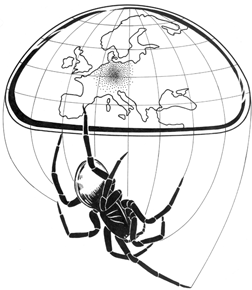Nachweis der Art Neobisium simile (Arachnida, Pseudoscorpiones) im Vorgebirge des Teutoburger Waldes
The finding of the species Neobisium simile (Arachnida, Pseudoscorpiones) at the foot of the Teutoburger Wald mountains
Germany; low mountain range
Abstract
The finding of the species Neobisium simile (Arachnida, Pseudoscorpiones) at the foot of the Teutoburger Wald mountains
Thomas Baumann (1997): Populationsökologie und zönotische Untersuchungen zur Bedeutung von Habitatqualität und Habitatfragmentierung für Spinnenpopulationen auf Trockenrasen am Beispiel von Eresus cinnaberinus (Oliv., 1789)
Thomas Baumann (1997): An ecological and coenotical population survey on the impact of habitat quality and habitat fragmentation on spider populations in dry grasslands using the spider Eresus cinnaberinus (Oliv., 1789) as an example
book review
Abstract
book review: Thomas Baumann (1997): An ecological and coenotical population survey on the impact of habitat quality and habitat fragmentation on spider populations in dry grasslands using the spider Eresus cinnaberinus (Oliv., 1789) as an example.
Jutta Barthel: Einfluss von Nutzungsmuster und Habitatkonfiguration auf die Spinnenfauna der Krautschicht (Araneae) in einer süddeutschen Agrarlandschaft
Jutta Barthel: Einfluss von Nutzungsmuster und Habitatkonfiguration auf die Spinnenfauna der Krautschicht (Araneae) in einer süddeutschen Agrarlandschaft
book review
Abstract
book review: Jutta Barthel: Einfluss von Nutzungsmuster und Habitatkonfiguration auf die Spinnenfauna der Krautschicht (Araneae) in einer süddeutschen Agrarlandschaft
Tagungsbericht zum Workshop "Autökologische Einstufung von Spinnen" am 23.11.96 auf Gut Sunder veranstaltet durch die Nordwestdeutsche Arachnologische Arbeitsgemeinschaft (NOWARA) unter der Leitung von A.Lisken-Kleinmans und H.-C.Fründ
Tagungsbericht zum Workshop "Autökologische Einstufung von Spinnen" am 23.11.96 auf Gut Sunder veranstaltet durch die Nordwestdeutsche Arachnologische Arbeitsgemeinschaft (NOWARA) unter der Leitung von A.Lisken-Kleinmans und H.-C.Fründ
Araneae; congress report; ecological classification
Abstract
congress report, ecological classification of spiders
Darstellungsmöglichkeit der Zugehörigkeit von Spinnenzönosen zu Pflanzenformationen. Mit einem Beispiel aus der Auenlandschaft im Nationalpark "Unteres Odertal"
Different ways to describe the affiliation of spider communities to defined plant associations
Araneae; plant association; floodplain
Abstract
Two different approaches of transferring research-data into diagrams are explained. Using an example from foodplain stands of the river Oder (National Park 'Lower Oder Valley'), the possible implications on and differences in the interpretation of the results, depending on the chosen method, are discussed.
Untersuchungen zur Spinnenzönose (Araneae) der Stamm- und Kronenregion von Eichen unterschiedlich genutzter Waldstandorte unter Verwendung des Ökotypensystems nach Platen
Studies on the spider coenosis (Araneae) of the trunk and canopy region of oaks in differently managed forest areas with reference to the Platen ecotype system
Araneae; Quercus robur; trunk fauna; canopy fauna; eclectors; forest management; ecotypes
Abstract
In 1995 the spider coenosis of two differently managed forest areas with Querco-Carpinetum communities were investigated near Bonn. In order to collect the canopy and trunk fauna two trunk-photo-eclectors and six bough-photo-eclectors were used in each study site. According to the PLATEN ecotype sysem, 16 different ecotypes of spiders were found. The highest abundances of both species and individuals were recorded for excusively arboricolous and for bark inhabiting spiders. Against the expectations a high number of non-arboricolous species and many xerophilous woodland inhabiting spiders were found. According to the PLATEN ecotype system, the latter are actually typical for mixed pine forests. The PLATEN ecotype system showed clear differences between the strata, but not between the study areas.
Ermittlung charakteristischer Spinnengemeinschaften von Biotoptypen am Beispiel der nordwestdeutschen Küstenregion
Investigation of characteristic spider communities of biotope types taking the northwest German coastal area as an example
spider communities; biotope types; classification method
Abstract
A classification method for ascertaining characteristical spider communities of different biotope types is presented. Based on a current list of biotope types all data available from a certain area about the spatial distribution of spiders were fed into a data bank an analysed. A largely standardized method has been developed which allows to classify the spider community of each biotope type. The classification is based on a presence/absence matrix and a comparison between the grades of presence in different biotope types.
Spinnenfänge aus Magerwiesen der Kantone Genf und Waadt (Schweiz) – Unkommentierte Artenlisten
Spiders of dry, unfertilized grasslands in the Cantons of Geneva and Vaud (Switzerland) – species lists
Araneae; spider
Abstract
Spiders of dry, unfertilized grasslands in the Cantons of Geneva and Vaud (Switzerland) – species lists


